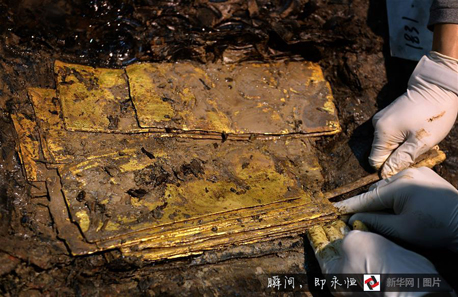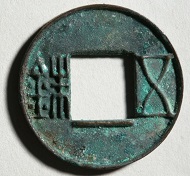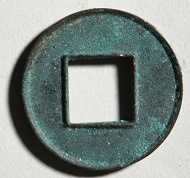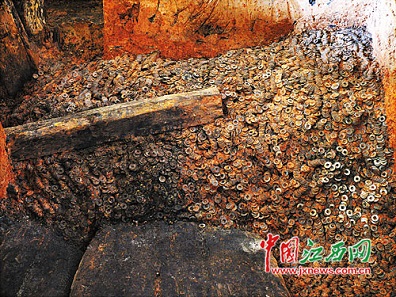by Jun Liu / Xinya Yang / Sven Günther
February 11, 2016 – Tons of bronze coins, and precious gold! These are the astonishing findings from ongoing excavations at a site of a vassal tomb on Guodunshan Hill in Guanxi Village, Xinjian District, Nanchang, Jiangxi Province, P.R. China. Dated to the Western Han Dynasty (202 B.C. to A.D. 8), the recently discovered coin hoard consists of 10 tons of bronze coins, as well as 20 pieces of gold tablets, 285 pieces of gold plates, and two kinds of gold ingots.
The gold tablets in situ. Source: Xinhuanet.
The owner of the tomb can be identified with a historical character, He Liu (92-59 B.C.), the first Lord of Haihun, a second level vassal of the Western Han Dynasty. Liu He was born as the son of the first King of Changyi (a first level vassal of the Western Han Dynasty), named Bo Liu (ca. 100s-88 B.C.), the fifth son of Emperor Wu (reigned 141-87 B.C.). At his age of five, He Liu inherited the title of his father. After the death of the successor of Emperor Wu, he was enthroned as the new Emperor in the summer of 74 B.C., but was dethroned immediately for his immodest behaviors in his reign after twenty-seven days and sent back to his origin, Changyi. At the same time he was deprived of his former title as king. In 63 B.C., he was moved to Haihun County, Yuzhang Shire (nowadays in Jiangxi Province) and invested with the rank of a “Lord”, titled after his new feud.
Whuzu coin. Source: China Numismatic Museum.
The coin hoard from the recently excavated site provides much new knowledge about his times. All the bronze coins from the site are so-called wuzhu, the standard coin casted by the central government of the Western Han Dynasty since the fifth year of the Yuanshou era (118 B.C.) under the reign of Emperor Wu. Following the example of Emperor Wu, almost every dynasty casted wuzhu coins as their own standard currency until its abolishment in the fourth year of the Wude era (A.D. 621) by the first emperor of Tang Dynasty (618-907 A.D.).
Wuzhu is a kind of coin which value is equal to its own weight. Zhu was the tiniest weight unit of measurement. In the weight system of the Western Han Dynasty, zhu was one twenty-fourth of the liang unit – one liang in this Dynasty is equal to 15.625 grams. Wuzhu means “5 times zhu” and is therefore equal to 3.255 grams. According to the measurement of true samples, most of the wuzhu coins of the Western Han weigh from 3.5 to 4 grams.
Following the banliang coins of Qin Dynasty (221-207 B.C.), the shape of the wuzhu coins is a round flake with a square hole in its very middle and higher outer edge (circle) and inner edge (square). The diameter of the wuzhu coins of the Western Han Dynasty ranges from 25 to 26 mm, the side length of its square hole from 9 to 10 mm, and both higher edges are about 1.5 to 2 mm in thickness and from 1 to 1.4 mm in width. The obverse legend is composed of the two Chinese characters for wuzhu in Seal Script; the reverse is blank with the higher edges.
The stack of the wuzhu coins in situ. Source: JXNews.com
What seems really interesting for the scholars, are two aspects. Firstly, it is the stacking form of the coins. The whole hoard was found in the northern storage of the main vault, and the amount is nearly 2 million. However, they were stacked quite regularly. Every one thousand coins were bunched together by twisted hemp, and the coin bunches were horizontally and vertically laid side by side, layer by layer, forming a cube of above 1.2 m in height. The contiguous layers were marked by wooden wedges tied with ropes. Obviously, this stack form is convenient for accounting the amount of the coins in the storage. Thus, it is a good example of the coin storage practice in the Western Han Dynasty.
Secondly, the bunch composed of one thousand coins provides material testimony for guan, one of the account units of ancient Chinese coins. That the unit guan is composed of one thousand coins, has been quite well known since Song Dynasties (960-1279 A.D.), but it was up to now not quite sure how many coins formed one guan before the Song Dynasties, especially before the Tang Dynasty. According to the quotation from Fei Li’s (ca. 2nd century A.D. or early 3rd century A.D.) annotation in the commentary by Shigu Yan (581-645 A.D.) on the sentence “to tax the businessmen first time by the bunched coins” in the “Annals of Emperor Wu,” in History of the Former Han, one guan is composed of one thousand coins. The information from this coin hoard testifies this record, and brings the origin of such a composition forward at least to the Western Han Dynasty.
Among the finds of the excavation, there is another interesting object, namely a fragment of a mold for casting wuzhu coins with the Chinese character chang (probably, it is the first character of the former title of the tomb owner). It might be a proof that vassals casted piratical, illegal coins against the prohibition since the period of Emperor Wu.
The gold plates (right) with ingots in situ. Source: Xinhuanet.com.
The newly published gold finds from the site are most considerable in the excavations of tombs, dated to the Qin and Han period (221 B.C. – A.D. 220). It is the first time that gold tablets are found from tombs dated to the Han period (202 B.C. – A.D. 220) during the excavation. The total amount of the gold tablets is 20. All have been found between the main coffin and its outer coffin. The size of these gold tablets is ca. 230 mm in length, ca. 100 mm in width, and ca. 3 mm in thickness. Furthermore, 285 pieces of gold plates have been found in different places in the tomb, in which 96 pieces are found in the main coffin, and another two boxes with separately 88 pieces and 99 pieces in the main outercoffin.
Matijin (left and right) and Linzhijin (middle) in situ. Source: Xinhusnet.com.
Besides the gold tablets and plates, there are two kinds of gold ingots, matijin (gold ingot in shape of a hoof) and linzhijin (gold ingot in shape of the toe of kylin, a mythical Chinese animal). On the surface of some matijins, there are three Chinese characters, which have quite a lot of meanings in ancient Chinese and have not been interpreted clearly by the experts yet.
According to Qian Sima (a contemporary historian of Emperor Wu), the First Emperor of the Qin Dynasty (reigned 247-210 B.C. and since 222 as emperor) the gold accounted by the unit yi (equal to 24 liang) as the higher money and the cast bronze coins with the weight of a half liang as the lower money. Although it cannot be made sure whether the gold plates and ingots were used as money in commerce, all of the gold finds from the site seem to function as storage of value. Until now all of the gold finds are not weighed up. However, the importance of the site for the political and economic history of the period cannot be doubted.
P.S.: The archaeological report of the excavation is not yet published. All the information, except the historical records and numismatic data of the wuzhu coin, and the photographs, are collected from the news on internet.
So far Chinese media have reported more detailed on the excavation. You can see more images from the excavation here.
Some further information on the whole excavation were presented on the Ancient Origins website and on RT.










